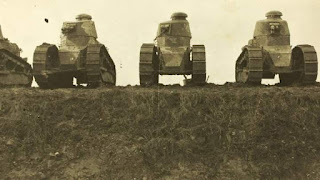The Renault FT 31 May 1918, the German army launches a sudden attack near the Forest of Retz near Ploisy in the north-east of France
The Renault FT
31 May 1918, the German army launches a sudden attack near the Forest of Retz near Ploisy in the north-east of France. It is the last year of World War One, and the Germans are desperately trying to beat the Western Allies.
A British blockade is crippling the German economy. Those back at home are suffering shortages of fuel and food. The German Empire faces starvation and defeat.
As the French units at Retz try to resist the onslaught, they are joined by reinforcements. Among them is a new tank: the FT. Compared to the giant, lumbering British tanks that have been used with mixed results for the past 18 months, these are tiny. There is only room for two people inside them.
But they are remarkably effective. The 30 tanks rushed to this battle help to push the Germans back. The tanks only stop advancing because the accompanying infantry cannot keep up with them.
At the site of this action, a century later, there is now a plaque, commemorating the first use of what is arguably the ancestor of every modern tank. The tiny FT is a paradigm of far-sighted design.
And it owes its existence to an unlikely pairing: a pragmatic artillery officer and one of France’s most renowned carmakers.
Jean Baptiste Eugene Estienne was considered one of France’s most visionary artillery commanders. He was a gifted mathematician, a philosopher and a lifelong student of Ancient Greece.
He also saw how new technology was changing warfare.
He was an early pioneer of indirect fire – guns firing at the enemy from behind cover, guided by an observer – and worked on machinery that would make this possible. In 1907 he became head of the artillery school in Grenoble.
As early as August 1914, Estienne believed a gun-armed, armoured vehicle could be decisive in the coming conflict. "Gentlemen, the victory in this war will belong to which of the two belligerents which will be the first to place a gun of 75 [mm calibre] on a vehicle able to be driven on all terrain," he told a group of French artillery officers in 1914.
There would be urgent need for a much smaller and lighter tank, one able spread out and attack enemy formations from the rear
Estienne got permission to create a prototype from French military commander General Joffre. Estienne then approached one of France’s most respected car designers, Louis Renault, to build it.
But Renault did have another idea. He thought that once the trenches and shellhole-strewn landscapes were crossed, there would be urgent need for a much smaller and lighter tank – one able spread out and attack enemy formations from the rear, in much the same way cavalry had done over the centuries. Renault also realised that contemporary engines wouldn’t be able to move a heavy tank across such difficult terrain at a useful speed.
He decided to create something much lighter. Renault worked with designer Rodolphe Ernst-Metzmaier on the new tank.
It sported several revolutionary features. It was the first to carry its armament – either a machine gun or a 37mm cannon – in a turret that could spin 360 degrees. While the British tanks had crews of up to 12, this one was controlled by a driver sitting in the front and the turret by the commander/gunner directly behind him.
And the engine was located in the rear, in a separate compartment – a configuration that almost every tank since has adopted.














Comments
Post a Comment